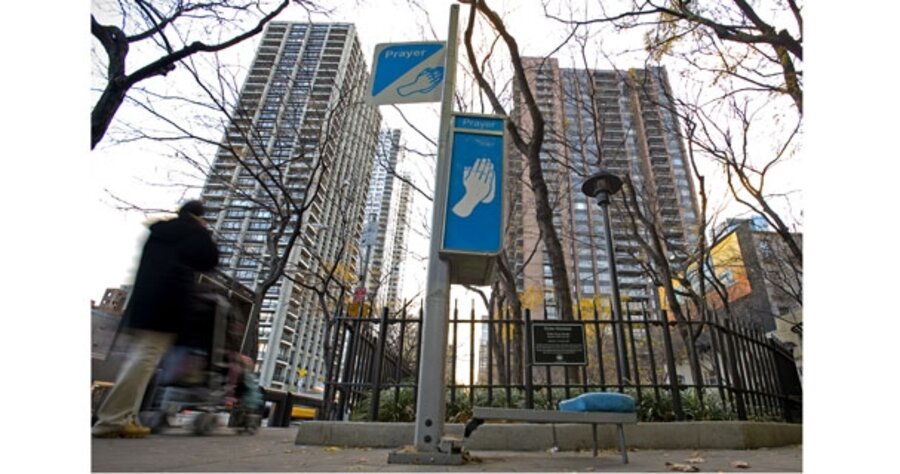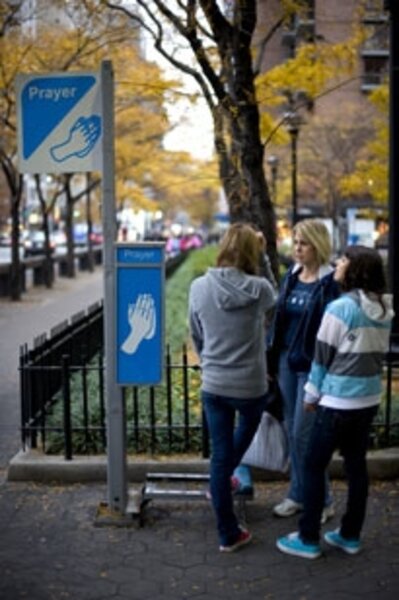The prayer booth: an artist’s “exhibit” of faith
Loading...
| New York
NEW YORK
Many will offer elaborate prayers of thanksgiving at dinner tables and houses of worship this week, but for those who want to phone it in, well, they can do that, too. Prayer stations – public telephone enclosures fitted out with kneelers, and signage modified to advertise “prayer”– have been offering believers a whole new take on the idea of calling long distance.
In New York, the “Public Prayer Booths,” a public art project, until this week graced a pocket park at Second Avenue and 59th Street, underneath the Roosevelt Island tram station. They were installed in September by Kansas City, Mo., artist Dylan Mortimer, who has similar exhibits in Jackson, Tenn., and in Cedar Rapids, Iowa.
“My intention is mainly to spark the dialogue about how individual faith functions in the public sphere,” the artist explains.
While some viewers focus on the art side, others take the invitation to dialogue literally: in New York, the prayer stations have had their share of users. Surrounded by graceful benches and tidy gardens, the booths have tended to be mistaken, at first glance, for public telephones. Then comes the double-take, then the giggles, the stares, the “no way!” incredulity, then the picture-taking, and, of course, the teenagers feigning prayer on a dare.
Residents and area workers who frequent the park have long settled into their opinions, which they shared during the last days of the installation there. Says Amir Jones, relaxing with a box lunch, “It’s more about provoking thought than about functioning, in my opinion.” With him, Bill Scanga, a production manager for a local gallery, observes that “it looks like a joke to me.” And indeed someone trying one out might expect to become, at any second, an unwitting foil in a David Letterman gag.
After all, few could imagine actually praying here. For one thing, there’s not even a pretense of privacy – no closet to “enter into.” In New York, there’s the lunch crowd and the pigeons and the strollers threatening to clip the ankles. There’s the half-dozen lanes of Queensboro Bridge traffic thundering by, horns honking, sirens screaming, so that even earthly conversation blows by only half heard. One booth had the distraction of the printed user directions: “at the completion of your prayer, please return the kneeler to its upright position”; the other, had the distracting fact that the instructions had been ripped out. The booths seem a kind of fake-out, suggesting the hushed sanctuary but serving up something faintly Euro – a spare, graffitied, garishly colored kiosk. No thank you.
But Mr. Mortimer sees the urban surrounds as a contemporary counterpart to the stained glass of yesteryear, and is no more put off by the notion of praying in the park than he is by making a phone call there. “It has all the same problems of a public telephone call – yeah, there’s some awkwardness.”
Kalsang Bhuming, whose carpet store abuts the park, is not so sure. It’s a nice thought, he laughs. “But I really do not see how someone can use that space. It is way too open.” Citing truly enclosed praying booths he has seen in other countries, he dismisses these as impractical “prayer poles.”
But the potential does seem to be there, as evidenced when a woman confidently walks up, lowers the cushy kneeler, has her moment, and moves on down Second Avenue, as nonchalant as if she’d just taken some cash out of an ATM.
James Jenkins, who works for the Doe Foundation, relaxes daily in the park on his lunch hour and seems to share her unselfconsciousness.
“We have everything on the streets of New York, and sometimes you have to take a little break. God’s going to talk to you wherever you are. So you go in there and it’s your own sanctuary,” says Mr. Jenkins, who knelt for prayer there several times. “I don’t care what people think. When you kneel down there, people give you room. They don’t bother you, [whereas] if you were to stop in the middle of the sidewalk and look up at the sky and pray, people would think you’re crazy.”
Some take the telephone concept literally. Mail carrier John Chang, who found the booths too open for his own comfort, nevertheless has no doubt that they function as designed. “You believe you can call somebody on a [real] telephone and make a connection with the one on the other end. Same here. But you have to believe it,” he insists.
Of course, not everyone believes, not everyone’s a fan. “I think it’s a waste. I see no need for it,” says resident William Holland, explaining that he is not a religious or praying person. “It‘s not my thing.”
At first, a neighborhood group tried to have the booths removed, arguing that public property was no place for art suggestive of religion, that the public should not be forced into prayer, recalls Mortimer. The city, he says, responded that the exhibit was no more forcing prayer “than the presence of a phone booth is forcing you to make a phone call."
He was hardly surprised at the opposition, though. The subject of all his artwork – faith and prayer – “is either avoided or heavily abstracted or treated cynically, especially in the art world, where supposedly anything goes,” he says. He wants the humor to be a bridge across the ideological divide.
The New York booths are two of the four that Mortimer, a graduate of New York’s School of Visual Art master’s program, has been displaying around the country since he first created the work in 2003. The broad range of reactions – love it from a distance, hate it, use it as a joke, use it seriously – are all valid, says Mortimer, pastor to the small Rivercity Community Church in Kansas City.
But he clearly appreciates those who are moved spiritually by his work. “Emails tend to be along the lines of ‘I was overwhelmed by life, or I was so busy, and I saw this and it reminded me to pray.’ And then they’ll list the things or people they pray for.”
One woman, writing of her loneliness in the big city, sees the exhibit as “a sort of hope for her – a ray of light in the gloom and doom of New York City.”
So does Janette Maron, who works nearby at Bloomingdale’s. “It’s sweet. I don’t know why. There’s just something very special about it,” she says, especially this fall, as many in her city reel from layoffs and threats of layoffs, and as retail girds for what may be a bad season. “I haven’t tried it … yet,” she adds.
Sammy Andino, a security officer for the local business improvement district, is another who considered having a kneel.
“Five minutes wouldn’t be so bad – the barest of time,” he muses. “I’d be thankful for my day, that I’m healthy…. It wouldn’t be embarrassing to praise the Lord there, to thank the Lord, even if I was in my uniform. After all, He’s the One who gave us life.”






